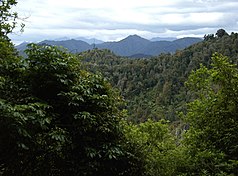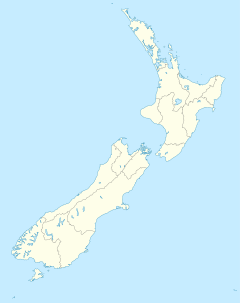Te Urewera National Park
| Te Urewera National Park | ||
|---|---|---|
| Looking towards East Cape | ||
|
|
||
| Location: | Gisborne , New Zealand | |
| Specialty: | largest jungle on the North Island | |
| Surface: | 2127 km² | |
| Founding: | 1954 | |
| Address: | Aniwaniwa Visitor Center State Highway 38, Aniwaniwa Private Bag 2213 Wairoa Tel. 64 6 837 3900 |
|
The Te Urewera National Park (English Te Urewera National Park ) was founded in 1954 to protect the largest preserved virgin forests on New Zealand's North Island .
geography
The national park is located between the Bay of Plenty and Hawke's Bay regions in the east of the island and extends over an area of 2127 km². It is thus the largest national park in the northern part of New Zealand and reaches up to heights of 1393 m .
The park is located in one of the most remote and most sparsely populated regions of New Zealand, in which a largely unimpaired, almost completely forested wilderness has been able to assert itself. The terrain of Te Urewera is shaped by the Huiau and Ikawhenua mountain ranges ; the highest peak in the national park is the Manuhoa with 1393 m. There are geological traces of earlier volcanic eruptions. Numerous lakes, e.g. B. Lake Waikaremoana , rivers and waterfalls contribute to a great variety of landscapes. Depending on the terrain and altitude, the climate in the national park varies with generally moderate temperatures with high amounts of precipitation. In the southern part, snow falls at higher altitudes in winter.
Flora and fauna
The vegetation also differs greatly depending on the location, altitude, soil conditions, etc. The predominant tree species are beech , rimu , rata and tawa ( Beilschmiedia tawa ). The wildlife of the Te Urewera National Park is particularly notable for the fact that it contains numerous rare bird species that are extinct or endangered in other parts of New Zealand. To them, for example, is one of the rare Saumschnabelente , also known as blue duck that lives only in fast-flowing waters.


